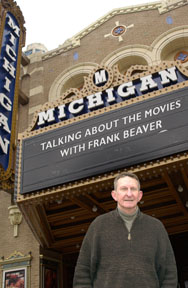
This web page is part of the Michigan Today Archive. To see this story in its original context, click here.
BERATING THE RATINGS By Frank Beaver After a decade of watching and analyzing nearly 2,000 feature films, researchers at Harvard’s School of Public Health recently concluded that the Motion Picture Association of America’s (MPAA) rating criteria and standards for movies were constantly changing, and that the age-oriented rating categories offer little clarity with regard to candid material (sex, violence, language). The Harvard study recommended the creation of a rating system with standardized universal criteria that could be adopted by other entertainment media as well. The MPAA rating system was a good-will “replacement” gesture on Hollywood’s part after it became clear that its old Hays Code, a self-regulatory procedure, was dramatically out of touch with the times. I was in my first year of film doctoral work at Michigan when the MPAA system went into effect in 1968. As a student, then teacher and later radio film critic for 25 years, it was not difficult to discover, way back when, the problems with the rating system that the Harvard researchers have just identified. In its earliest years, the Motion Picture Association was so concerned about sexuality on the screen that it issued its harshest rating, the dreaded X, to important works such as MIDNIGHT COWBOY (1969), MEDIUM COOL (1969) and A CLOCKWORK ORANGE (1971). At the same time, however, a low-budget law-and-order film in which a child is tossed into the air and impaled on a pitchfork received a G-rating, meaning the MPAA deemed it acceptable for General audiences. Motion picture theater owners quickly discovered how an X or R rating could affect their standing in the community and, increasingly, they adopted policies of not showing X-rated films, although the X rating was supposedly meant for a film containing adult material suitable for viewers 17 years old and up. Some even banned R-rated films. The boycott of X-rated films was so immediate and powerful that Stanley Kubrick recalled prints of A CLOCKWORK ORANGE and deleted a satiric pixilated sex scene in order to win an R-rating. The use of the X rating became so controversial that in 1990 the MPAA was forced to re-label that category NC-17. The lack of clear ratings standards that would inform filmgoers about what they were likely to encounter in a film was apparent from the onset of the rating system. A case in point: RYAN’S DAUGHTER (1970), David Lean’s film about love relations in a small coastal Irish town, had some graphic sexual seasons yet received a PG rating (Parental Guidance recommended). A public furor erupted among parents who, thinking that they understood the parameters of a PG rating, had taken their teenagers to see the film and been shocked by what they saw with youngsters in tow. The Harvard researchers concluded that over the 1992-2003 period they studied, the country grew increasingly lenient toward once-objectionable content within the age-oriented categories. They called the trend “ratings creep.” But ratings creep plagued the system long before 1992, and the MPAA has consistently been forced to alter and update its classification symbols. In 1984, the MPAA added a new category, PG-13 (parental guidance strongly suggested for children under 13). The demands for refined guidelines had intensified after PG-rated films such as GREMLINS (1984)—which visualized small animals exploding in a microwave—had been considered too terrifying for the very young. More letters were added to an already murky alphabet soup. It seems plain to me that the Hollywood rating system has never had much success as a device for informing anxious or curious moviegoers about what they are going to see on screen. The use of symbolic letters in any kind of classification scheme is destined for ambiguity and confusion. And I have my doubts that the Harvard researcher’s call for a “standardized universal rating system” will result in a more precise rating system. Film expression, as with theater and dance, deserves evaluation in narrative form—informed discussion of and opinion on the work as a whole. The narratives wouldn’t have to be long. Short enough to run in the local newspaper alongside the ads for films playing at local theaters. Wishful thinking perhaps, but the MPAA’s team of diversified rating experts could try it as an alternative to the current, failed system. I’m convinced that filmgoers of all ages would benefit. |
|
Michigan Today News-e is a monthly electronic publication for alumni
and friends. |
| MToday NewsE | |||
|
Michigan Today
online alumni magazine
University Record
faculty & staff newspaper
MGoBlue
athletics
News Service
U-M news
Photo Services
U-M photography
University of Michigan
gateway
|
• Maps |
 Film
historian and critic
Film
historian and critic 